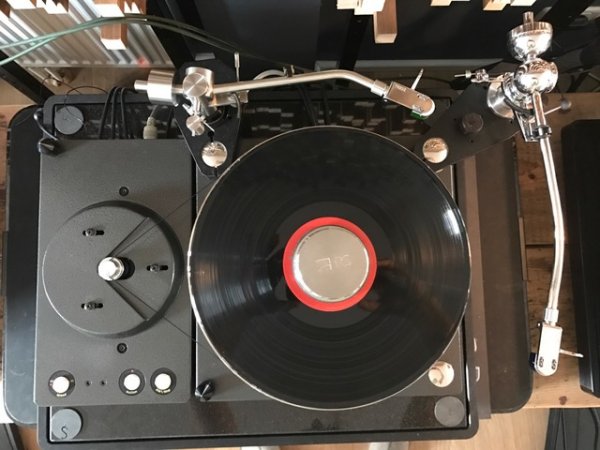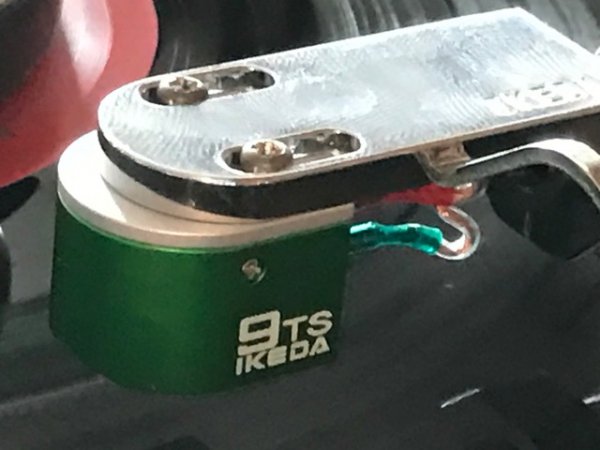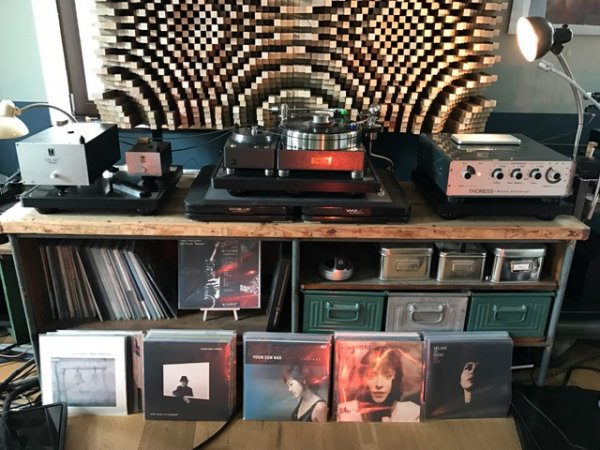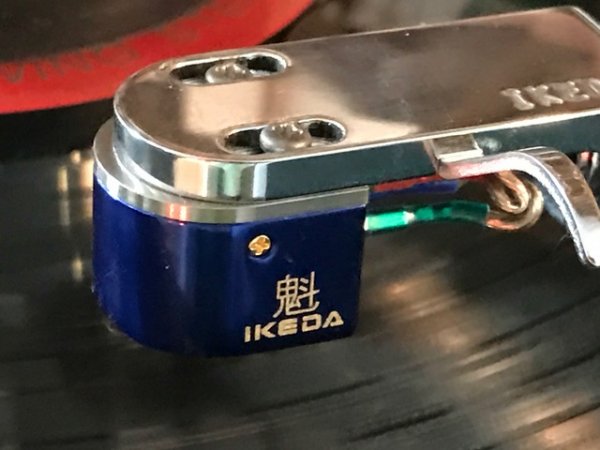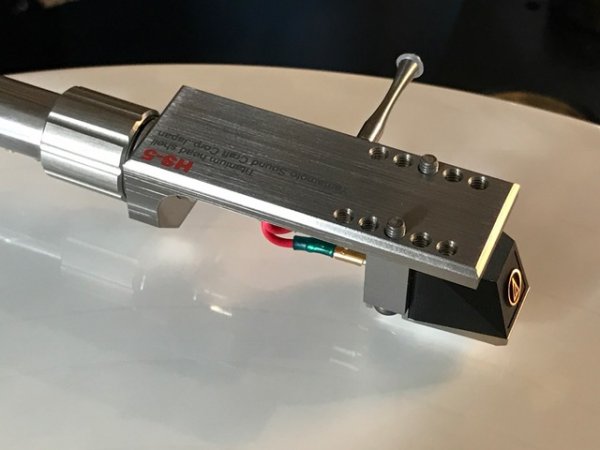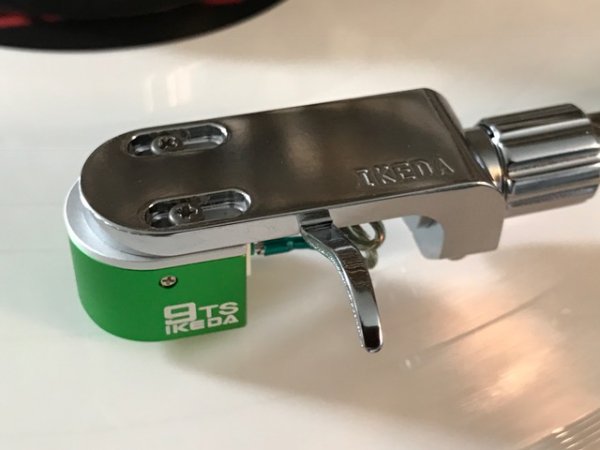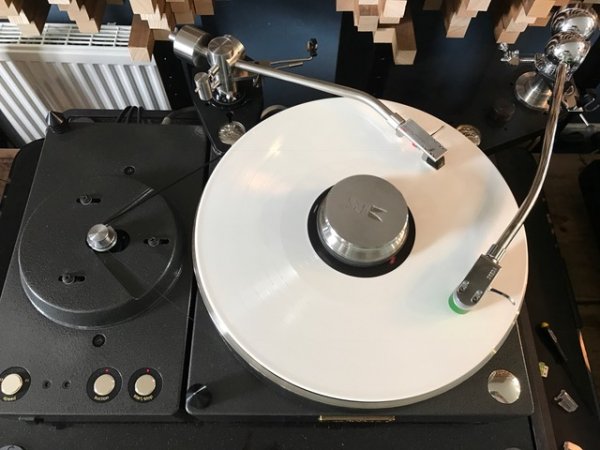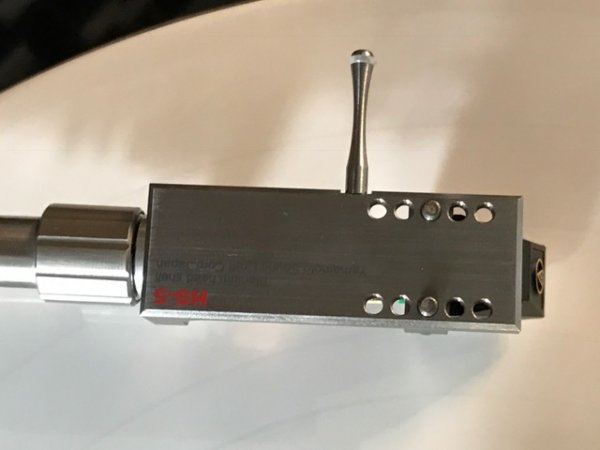Since a couple of days, I am enjoying my Micro Seiki SX 8000 MKII turntable.
It was clear to me, that I like to combine this heavy turntable with heavy arms and low complient cartridges. recently I saw a Micro Seiki SX 8000 MKII with SME V and Kuzma 4 point tonearm, which might be a nice combination, but does not look like, what I would expect from such a turntable
(I know , the SME V is old as well, but still looks very modern).
So I have choosen the SAEC 407/23 Tonearm and the Ikeda 407 Tonearm to be combined with Ikeda 9TS and KAI cartridges.
As the SAEC 407/23 was not a perfect match (too analytic and not enough "rich" bass) on the original brass base from Micro Seiki ,
I fitted the SAEC on an aluminium base and my Micro Seiki RX 1500, which is a much better balanced combination.
So I focussed next to the Ikeda 407 tonearm (with VTA lifter).
Looking into the Ikeda 407 manual will give you a 50mm distance from cartridge stylos tip to the headshell/arm interface,
with 295 mm pivot to spindle distance, which was my starting point, as you can see on the pics .
This starting point was supported by the obvious great fitment of the Ikeda Kai and 9TS cartridges in the Ikeda headshell, which is just looking perfect.
My idea to interchange the 2 cartridges in the Ikeda 407 arm, using the same Ikeda cartridge seemed to become difficult, as the two cartridges have a difference in weight. Ikeda homepage is showing 1,5g difference , but reality is arround 2g.
But 2g is in the reach of easily increasing the force by 2.2g for the 9TS, if balancing started with the Kai (9TS has 2g and Kai has1,8g tracking force).
I started the comparison (using Kondo M7 /Kondo SPZ and Thoeress PhonoPres) with the KAI, which sounded nice (after having had 30h on the Clearaudio break in disc), but compared to Transfiguration Proteus and vdh Colibri not with the quality level expected.
Changing to 9TS showed a much better performance in relation to the pricepoint. More dynamic and more resolution, Kai was not bettering 9TS in this area, only the smoothness of the mids were more nice.
I was also disappointing, that the KAI was not 100% able to do high dynamic and loud voices, where the 9TS had no problems. So I started to think about the 50mm distance..., as in former times the old Fidelity Research Arms tonearms had a recommandation of 51mm,
which is still the norm for cartridges like Ortofon SPU or Tedeska.
So I started to bring the KAI to a 51mm distance point.
To my surprise, this position, sounds better, but still not perfect. At the end I was bringing the cartridge back and forwards (adjusting the tracking force accordingly) . The sonic response of the KAI was drastic, I can not remember, that I have fitted a cartdrige, which is that sensible in this parameter.
Relatively easy I was able to find a good position, but as this is also effecting the VTA (not only tracking force) I have to do some more investigations, but already now, the sonic improvement was huge and I start to understand, why many people like the KAI so much and other people say, that the cartridge is "just ok".
I will post a picture of the KAI in the final position soon
But having done this exercise, I mmediately started to do the same with 9TS. To my surprise, the differences were audible, but in comparison very small. I would say not worth the effort...
Now I was able to compare the 2 cartridges and the sonic difference become more obvious, the KAi clearly betters the 9TS, but the 9TS has a fantastic performace for the price point, which is in Germany three times less as KAI.
Finally I decided to give a little more "shine" to the KAI and I installed Ortofon LW800s leadwire instead of the 4N Ikeda wires, which worked out good!
( I am coming from a day to day listening experence with vdh colibri, so this leadwire makes the change a little less different, may be I will exchange after a whilem getting better used to KAI, to 6N copper lead wire)
At the end , I decided, that Ikeda 407 and KAI works perfectly together on the Micro Seiki SX 8000 MKII turntable, rich bass, smooth mids , nice resolution at all, huge soundstange.
The Ikeda 9TS is a different animal, more modern , more punchy..., so I was looking for a tonearm with punchy bass as well, with a solidrock dynamic and a matching effective mass. After the not so harmonizing partnership with the SAEC 407/23, I was looking for a Fidelity Research FR 64s .
The FR64s should be very very close to the FR66s, but for a price, which is much more realistic and not (yet) driven by crazy collectors.
Fortunately I was able to buy a nearly NOS FR64s, which was never installed on a turntable, since decades waiting for a customer, just beeing on demo in a glass vitrine.
From another German collector I was able to buy the Fidelity Research N60 Tonearm stabilizer weight.
I was able to understand, that the Ikeda VAT lifter is not giving only the VTA lifter opportunity to the arm, but also increases resolution, stability and bassperformance of the 407, so it was clear , that I need the FR BA60 VAT lifter or as a compromise the N60 stabilizer for the FR64s tonearm.
The Ikeda 9TS has shown, that it does not change the performance too much, if played with different headshell positions, so I fitted the 9TS immediately to the FR64s to get a first impression.
And this first impression is just great! Like a perfect match, the FR64s (silverwiring) has so much brutal dynamics and sonic stability, that the 9TS plays like a rockmusic devil . I tried Queen "we will rock you" and this became a fanatstic listening fun.
. I tried Queen "we will rock you" and this became a fanatstic listening fun.
So my goal to have one Cartridge/Arm combination with high resolution and a more intime listening character and on the other side a more high dynamic, powerfull combination for the more dance floor like rythmattack approach (without loosing the High End bit of high resolution, realistic soundstage, realness..)
As the FR64s requires the old standard of 51mm stylus to headshell start distance, I was changing the postion of the 9TS accordingly. Mainly the soundstage improves, specially the hight of the instruments/vocals became more realistic.
But I believe, that I am not at the end to surch and find the final position of the 9TS as well.
Finally , after all the spent hours with Ikeda / FR Cartridges and Arms I have to say, that it is not easy to change from a Stevensen, (or any other curve) optimized cartridge placement to an just rough advice driven position, continuing the next steps by extensive listening.
The next steps are a multidimensional parameter universum of different sonic effects, but specially the KAI is a clear responding cartridge, which likes to help you to find the best position!
Juergen
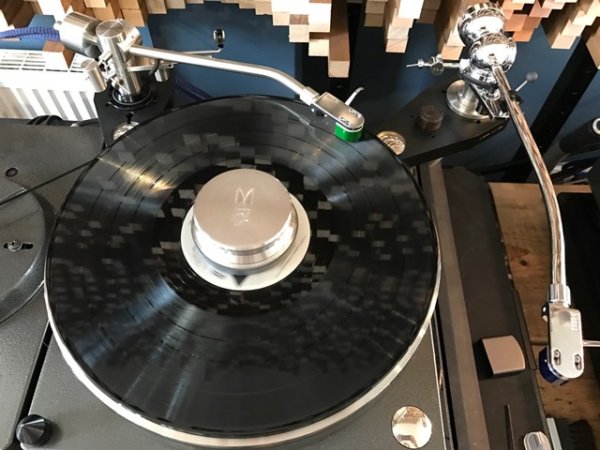
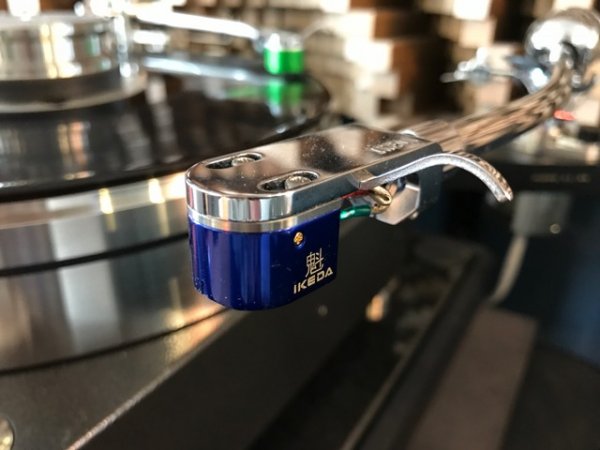
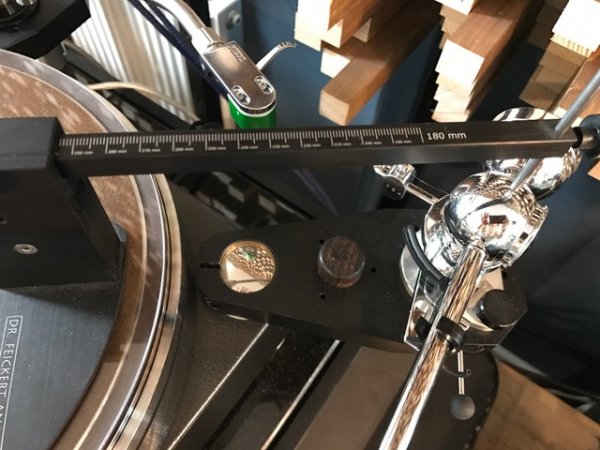
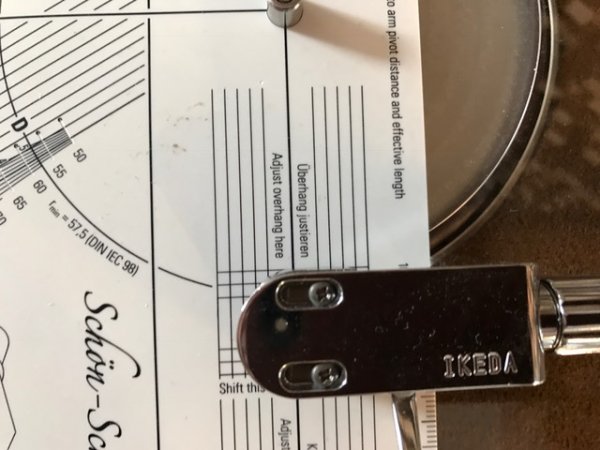
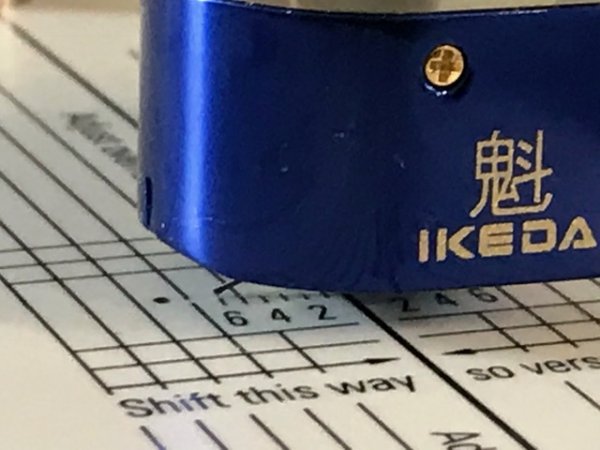
It was clear to me, that I like to combine this heavy turntable with heavy arms and low complient cartridges. recently I saw a Micro Seiki SX 8000 MKII with SME V and Kuzma 4 point tonearm, which might be a nice combination, but does not look like, what I would expect from such a turntable
(I know , the SME V is old as well, but still looks very modern).
So I have choosen the SAEC 407/23 Tonearm and the Ikeda 407 Tonearm to be combined with Ikeda 9TS and KAI cartridges.
As the SAEC 407/23 was not a perfect match (too analytic and not enough "rich" bass) on the original brass base from Micro Seiki ,
I fitted the SAEC on an aluminium base and my Micro Seiki RX 1500, which is a much better balanced combination.
So I focussed next to the Ikeda 407 tonearm (with VTA lifter).
Looking into the Ikeda 407 manual will give you a 50mm distance from cartridge stylos tip to the headshell/arm interface,
with 295 mm pivot to spindle distance, which was my starting point, as you can see on the pics .
This starting point was supported by the obvious great fitment of the Ikeda Kai and 9TS cartridges in the Ikeda headshell, which is just looking perfect.
My idea to interchange the 2 cartridges in the Ikeda 407 arm, using the same Ikeda cartridge seemed to become difficult, as the two cartridges have a difference in weight. Ikeda homepage is showing 1,5g difference , but reality is arround 2g.
But 2g is in the reach of easily increasing the force by 2.2g for the 9TS, if balancing started with the Kai (9TS has 2g and Kai has1,8g tracking force).
I started the comparison (using Kondo M7 /Kondo SPZ and Thoeress PhonoPres) with the KAI, which sounded nice (after having had 30h on the Clearaudio break in disc), but compared to Transfiguration Proteus and vdh Colibri not with the quality level expected.
Changing to 9TS showed a much better performance in relation to the pricepoint. More dynamic and more resolution, Kai was not bettering 9TS in this area, only the smoothness of the mids were more nice.
I was also disappointing, that the KAI was not 100% able to do high dynamic and loud voices, where the 9TS had no problems. So I started to think about the 50mm distance..., as in former times the old Fidelity Research Arms tonearms had a recommandation of 51mm,
which is still the norm for cartridges like Ortofon SPU or Tedeska.
So I started to bring the KAI to a 51mm distance point.
To my surprise, this position, sounds better, but still not perfect. At the end I was bringing the cartridge back and forwards (adjusting the tracking force accordingly) . The sonic response of the KAI was drastic, I can not remember, that I have fitted a cartdrige, which is that sensible in this parameter.
Relatively easy I was able to find a good position, but as this is also effecting the VTA (not only tracking force) I have to do some more investigations, but already now, the sonic improvement was huge and I start to understand, why many people like the KAI so much and other people say, that the cartridge is "just ok".
I will post a picture of the KAI in the final position soon
But having done this exercise, I mmediately started to do the same with 9TS. To my surprise, the differences were audible, but in comparison very small. I would say not worth the effort...
Now I was able to compare the 2 cartridges and the sonic difference become more obvious, the KAi clearly betters the 9TS, but the 9TS has a fantastic performace for the price point, which is in Germany three times less as KAI.
Finally I decided to give a little more "shine" to the KAI and I installed Ortofon LW800s leadwire instead of the 4N Ikeda wires, which worked out good!
( I am coming from a day to day listening experence with vdh colibri, so this leadwire makes the change a little less different, may be I will exchange after a whilem getting better used to KAI, to 6N copper lead wire)
At the end , I decided, that Ikeda 407 and KAI works perfectly together on the Micro Seiki SX 8000 MKII turntable, rich bass, smooth mids , nice resolution at all, huge soundstange.
The Ikeda 9TS is a different animal, more modern , more punchy..., so I was looking for a tonearm with punchy bass as well, with a solidrock dynamic and a matching effective mass. After the not so harmonizing partnership with the SAEC 407/23, I was looking for a Fidelity Research FR 64s .
The FR64s should be very very close to the FR66s, but for a price, which is much more realistic and not (yet) driven by crazy collectors.
Fortunately I was able to buy a nearly NOS FR64s, which was never installed on a turntable, since decades waiting for a customer, just beeing on demo in a glass vitrine.
From another German collector I was able to buy the Fidelity Research N60 Tonearm stabilizer weight.
I was able to understand, that the Ikeda VAT lifter is not giving only the VTA lifter opportunity to the arm, but also increases resolution, stability and bassperformance of the 407, so it was clear , that I need the FR BA60 VAT lifter or as a compromise the N60 stabilizer for the FR64s tonearm.
The Ikeda 9TS has shown, that it does not change the performance too much, if played with different headshell positions, so I fitted the 9TS immediately to the FR64s to get a first impression.
And this first impression is just great! Like a perfect match, the FR64s (silverwiring) has so much brutal dynamics and sonic stability, that the 9TS plays like a rockmusic devil
So my goal to have one Cartridge/Arm combination with high resolution and a more intime listening character and on the other side a more high dynamic, powerfull combination for the more dance floor like rythmattack approach (without loosing the High End bit of high resolution, realistic soundstage, realness..)
As the FR64s requires the old standard of 51mm stylus to headshell start distance, I was changing the postion of the 9TS accordingly. Mainly the soundstage improves, specially the hight of the instruments/vocals became more realistic.
But I believe, that I am not at the end to surch and find the final position of the 9TS as well.
Finally , after all the spent hours with Ikeda / FR Cartridges and Arms I have to say, that it is not easy to change from a Stevensen, (or any other curve) optimized cartridge placement to an just rough advice driven position, continuing the next steps by extensive listening.
The next steps are a multidimensional parameter universum of different sonic effects, but specially the KAI is a clear responding cartridge, which likes to help you to find the best position!
Juergen










